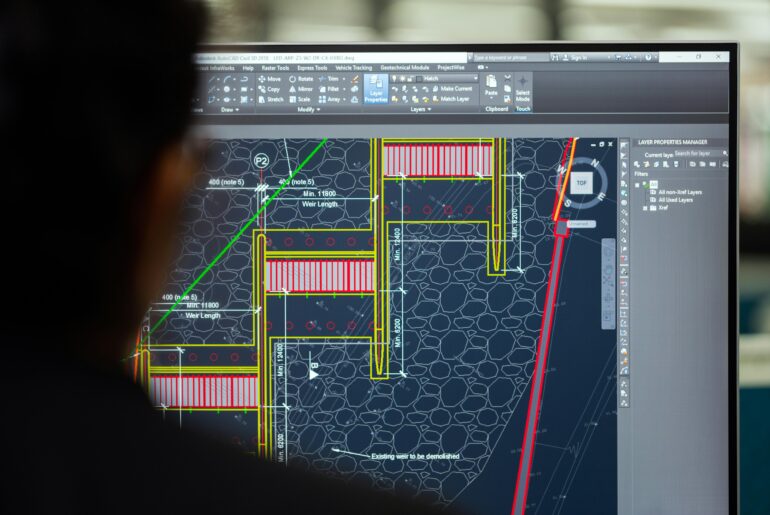This article may contain references to products or services from one or more of our advertisers or partners. We may receive compensation when you click on links to those products or services. Nonetheless, our opinions are our own.
The information presented in this article is accurate to the best of our knowledge at the time of publication. However, information is subject to change, and no guarantees are made about the continued accuracy or completeness of this content after its publication date.
- Introduction
- How Construction Management Has Changed
- Benefits of Using Construction Management Software
- Steps for Implementing Construction Software
- How to Overcome Implementation Challenges
- Success Stories From Small Construction Businesses
- Final Thoughts
- Frequently Asked Questions
- Recommended Reads
Introduction
Small construction businesses are increasingly adopting construction management software to streamline operations and improve overall efficiency. This modern approach has revolutionized project workflows by replacing outdated manual methods with digital tools for better planning, collaboration, and resource management. The shift helps businesses stay competitive in an industry marked by tight deadlines and growing complexity. With features like real-time tracking and document automation, construction software enhances responsiveness across all teams. Embracing this technology supports scalability and improved decision-making. This transition marks a turning point for small firms seeking consistent, profitable growth.
How Construction Management Has Changed
The Rise of Construction Software
Construction software has revolutionized how projects are managed. Offering features like resource planning, document management, and mobile accessibility, it enables construction professionals to collaborate effectively and deliver successful outcomes. Small businesses, in particular, benefit from the simplicity and functionality of these tools, which help them stay competitive in a demanding market.
Moving Beyond Traditional Methods
Traditional methods, though effective in the past, often fall short in managing today’s increasingly complex construction projects. Relying solely on outdated approaches can hinder growth and reduce efficiency. Embracing modern construction software allows businesses to optimize workflows, enhance communication, and better allocate resources, enabling them to thrive in a fast-paced industry.
Benefits of Using Construction Management Software
Increased Efficiency and Productivity
Construction management software automates repetitive tasks and improves communication among team members. Features like real-time updates and resource tracking enable small businesses to reduce delays, optimize resource use, and complete projects faster. The result is significant time and cost savings.
Enhanced Communication and Collaboration
Effective communication is crucial in construction projects. Management software centralizes project details, ensuring all team members, including contractors and field workers, have access to real-time updates. This streamlined communication reduces delays, improves teamwork, and enhances overall project outcomes.
Voted "Best Overall Budgeting App" by Forbes and WSJ
Monarch Money helps you budget, track spending, set goals, and plan your financial future—all in one app.
Get 50% OFF your first year with code MONARCHVIP
Steps for Implementing Construction Software
Assessing Your Business Needs
Before adopting construction software, assess your current project management processes. Identify areas where improvement is needed, such as document management, resource planning, or task allocation. Consider project complexity, team size, and collaboration with contractors to determine the features your business requires.
Preparing Equipment and Resources
Ensure your existing hardware, such as computers and tablets, is compatible with the software. A stable internet connection is essential for smooth operation. Budget for employee training to maximize the software’s effectiveness and ensure a seamless transition.
Transitioning to New Software
Identify business needs and evaluate available tools. Choose software that meets your requirements for document management, resource planning, and task management. Provide thorough training for your team to ensure they understand and can effectively use the new tools.
How to Overcome Implementation Challenges
Addressing Resistance to Change
Adopting new technology often creates apprehension among employees. To ease the transition, communicate the benefits of the software clearly. Involve team members in the decision-making process and provide comprehensive training and ongoing support. Demonstrating how the software simplifies tasks and improves productivity can help employees feel more confident and willing to adapt.
Learning to use construction management software takes time. To help your team adapt, schedule practice sessions using real project scenarios. Utilize tutorials and customer support to address questions. Emphasize the long-term benefits, such as improved efficiency and faster project completion.
Success Stories From Small Construction Businesses
Case Study: Improving Project Management
A local construction company implemented construction management software to streamline operations. By centralizing project details and providing real-time updates, the software improved collaboration among team members, subcontractors, and project managers. As a result, the company reduced costs, optimized resource allocation, and delivered projects more efficiently, earning greater client satisfaction.
Case Study: Boosting ROI With Technology
A small construction firm used software to enhance project workflows, reducing labor costs and improving efficiency. Features like mobile access and real-time updates allowed the team to monitor progress seamlessly. This approach increased the firm’s return on investment, showcasing the financial benefits of adopting modern construction tools.
Final Thoughts
Construction management software provides major benefits for small construction businesses seeking to modernize operations. It improves project outcomes by enhancing communication, streamlining resource use, and increasing team productivity. By carefully assessing needs and investing in training, businesses can manage transitions smoothly and gain long-term advantages. These tools support better planning and execution across multiple projects. Overcoming resistance to change through education and inclusion is also critical. With the right strategy, small construction firms can use software to drive efficiency and stay competitive.
Frequently Asked Questions
What makes construction software better than traditional methods?
Construction software streamlines processes by automating tasks, improving collaboration, and providing real-time updates. Features like digital blueprints and automatic reporting enhance efficiency and reduce delays, making it superior to traditional methods. These tools help teams communicate more effectively and manage large volumes of data with ease. As a result, projects are completed faster and with fewer errors. Traditional paper-based methods often lack the scalability and speed offered by modern software solutions.
How do I choose the right construction software for my business?
To select the best software, first identify your business needs and workflow challenges. Evaluate the platform’s ease of use and ensure it integrates well with your current systems. Look for scalability so the software grows with your company. Testing trial versions and reading peer reviews can also help you make an informed choice.
Can construction software integrate with existing tools?
Yes, most modern construction software platforms are built to integrate with existing tools and systems. This helps businesses enhance workflows without needing to overhaul current operations. Integration improves data sharing between platforms and enables centralized project management. It also reduces manual data entry and ensures consistency across different teams and departments.
Is training required when switching to construction software?
Yes, training is essential to ensure that team members can use the software effectively. It helps employees understand new workflows, features, and project management strategies. Training also boosts adoption rates and reduces resistance to change. Many software providers offer onboarding resources, tutorials, and customer support to help with the transition process.

Reviewed and edited by Albert Fang.
See a typo or want to suggest an edit/revision to the content? Use the contact us form to provide feedback.
At FangWallet, we value editorial integrity and open collaboration in curating quality content for readers to enjoy. Much appreciated for the assist.
Did you like our article and find it insightful? We encourage sharing the article link with family and friends to benefit as well - better yet, sharing on social media. Thank you for the support! 🍉
Article Title: Best Construction Software for Small Businesses
https://fangwallet.com/2025/08/12/best-construction-software-for-small-businesses/The FangWallet Promise
FangWallet is an editorially independent resource - founded on breaking down challenging financial concepts for anyone to understand since 2014. While we adhere to editorial integrity, note that this post may contain references to products from our partners.
The FangWallet promise is always to have your best interest in mind and be transparent and honest about the financial picture.
Become an Insider

Subscribe to get a free daily budget planner printable to help get your money on track!
Make passive money the right way. No spam.
Editorial Disclaimer: The editorial content on this page is not provided by any of the companies mentioned. The opinions expressed here are the author's alone.
The content of this website is for informational purposes only and does not represent investment advice, or an offer or solicitation to buy or sell any security, investment, or product. Investors are encouraged to do their own due diligence, and, if necessary, consult professional advising before making any investment decisions. Investing involves a high degree of risk, and financial losses may occur including the potential loss of principal.
Source Citation References:
+ Inspo
There are no additional citations or references to note for this article at this time.












































